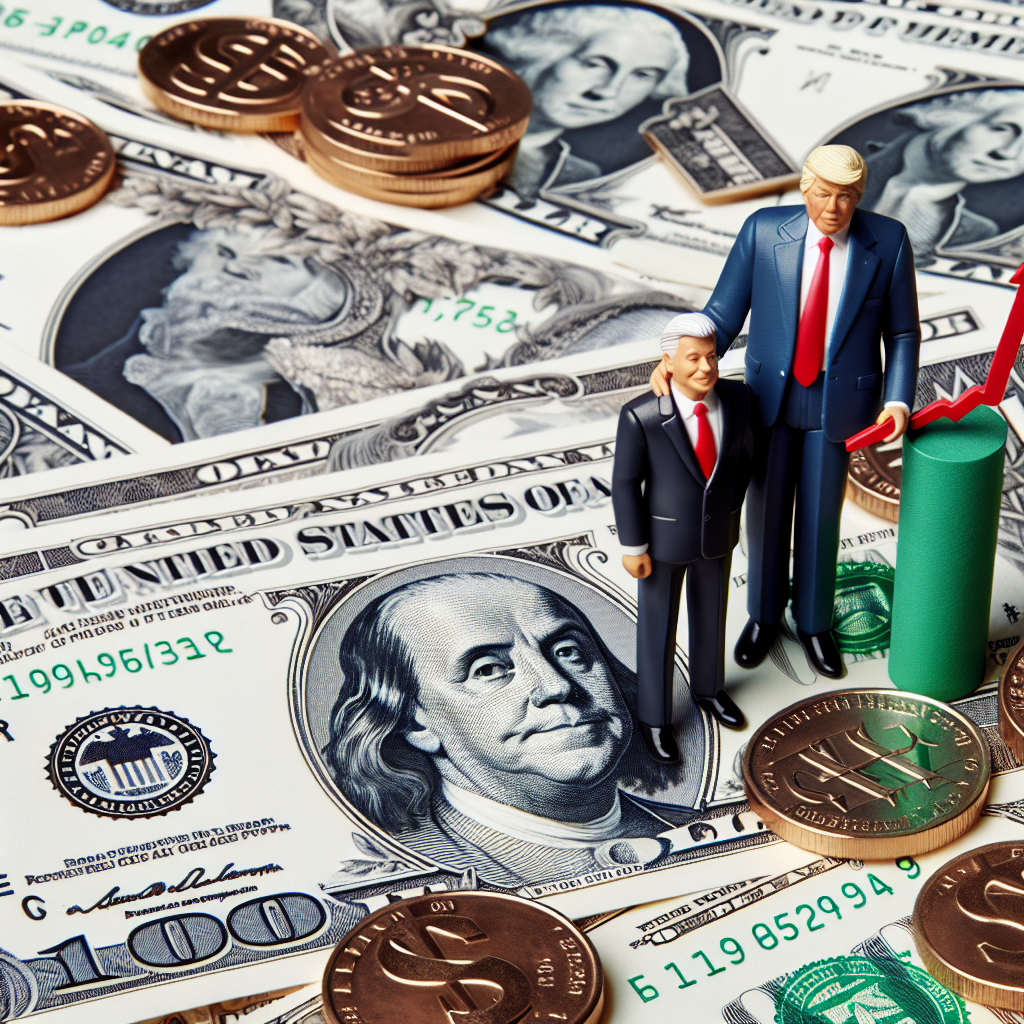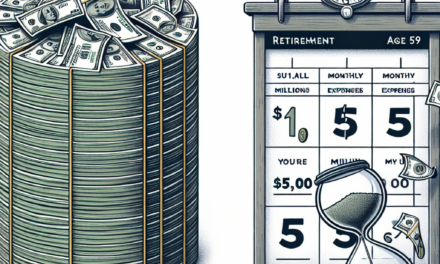“Trump’s Victory Propels Dollar to New Heights: A Year-High Surge”
Introduction
Following the unexpected victory of Donald Trump in the 2016 U.S. presidential election, the financial markets experienced significant volatility, with the U.S. dollar surging to a one-year high. This dramatic rise in the dollar’s value was driven by investor optimism regarding Trump’s proposed economic policies, which included tax cuts, deregulation, and increased infrastructure spending. These policies were anticipated to stimulate economic growth and inflation, prompting expectations of interest rate hikes by the Federal Reserve. As a result, the dollar strengthened against a basket of major currencies, reflecting heightened confidence in the U.S. economy’s prospects under the new administration.
Impact Of Trump’s Election Win On The Global Economy
The election of Donald Trump as the President of the United States in November 2016 sent ripples through the global economy, with one of the most immediate and notable impacts being the surge of the U.S. dollar to a one-year high. This unexpected political outcome prompted a reassessment of economic policies and market expectations, leading to significant shifts in currency valuations and investor sentiment worldwide. As markets digested the implications of a Trump presidency, the dollar’s ascent became a focal point for analysts and policymakers alike.
In the wake of Trump’s victory, the dollar’s strength was largely attributed to the anticipation of his proposed economic policies, which included tax cuts, deregulation, and increased infrastructure spending. These measures were expected to stimulate economic growth and potentially lead to higher interest rates as the Federal Reserve responded to inflationary pressures. Consequently, investors flocked to the dollar, viewing it as a safe haven amidst the uncertainty and volatility that characterized the immediate post-election period.
Moreover, the dollar’s rise was further fueled by the divergence in monetary policy between the United States and other major economies. While the Federal Reserve was on a path toward gradual interest rate hikes, central banks in Europe and Japan were maintaining or even expanding their accommodative monetary policies. This divergence made U.S. assets more attractive, drawing capital inflows that bolstered the dollar’s value. As a result, currencies such as the euro and the yen weakened against the dollar, amplifying its upward trajectory.
The implications of a stronger dollar were multifaceted, affecting various sectors of the global economy. For U.S. exporters, a robust dollar posed challenges by making American goods more expensive and less competitive in international markets. This, in turn, could potentially widen the trade deficit, a concern that Trump had frequently highlighted during his campaign. On the other hand, a strong dollar benefited U.S. consumers by reducing the cost of imported goods, thereby enhancing purchasing power.
Internationally, the dollar’s appreciation had significant repercussions for emerging markets, many of which had substantial dollar-denominated debt. As the dollar strengthened, the burden of servicing this debt increased, leading to financial strain in some economies. Additionally, capital outflows from these markets intensified as investors sought higher returns in the United States, further exacerbating economic vulnerabilities.
While the immediate impact of Trump’s election win was marked by the dollar’s surge, the long-term effects on the global economy were contingent upon the implementation and success of his policies. The initial optimism that drove the dollar higher was tempered by uncertainties surrounding trade relations, geopolitical tensions, and domestic political dynamics. As such, the global economy remained in a state of flux, with market participants closely monitoring developments in U.S. policy and their potential ramifications.
In conclusion, the dollar’s rise to a one-year high following Trump’s election win underscored the interconnectedness of global financial markets and the profound influence of political events on economic trajectories. As the world adjusted to the new political landscape, the dollar’s strength served as both a reflection of investor confidence in U.S. economic prospects and a source of challenges for various stakeholders across the globe. The unfolding of Trump’s presidency would continue to shape the contours of the global economy, with the dollar’s performance serving as a barometer of broader economic trends.
Currency Market Reactions To Political Events
The currency market is a complex and dynamic environment, often influenced by a myriad of factors, including political events. One such event that had a significant impact on the currency market was the election of Donald Trump as the President of the United States. Following his unexpected victory, the U.S. dollar soared to a one-year high, reflecting the market’s reaction to the anticipated economic policies of the Trump administration. This surge in the dollar’s value can be attributed to several key factors that are worth exploring to understand the broader implications of political events on currency markets.
Firstly, the anticipation of Trump’s economic policies played a crucial role in boosting the dollar. During his campaign, Trump promised substantial tax cuts, deregulation, and increased infrastructure spending. These proposals were perceived by investors as likely to stimulate economic growth and potentially lead to higher interest rates. Higher interest rates generally attract foreign capital, as investors seek better returns on their investments, thereby increasing demand for the dollar. Consequently, the market’s expectation of a more robust U.S. economy under Trump’s leadership contributed to the dollar’s appreciation.
Moreover, the election outcome led to a shift in market sentiment, with investors reassessing their risk appetite. The initial uncertainty surrounding Trump’s presidency gave way to optimism about potential economic reforms. This shift was further bolstered by the Republican Party’s control of both the House of Representatives and the Senate, which was expected to facilitate the implementation of Trump’s policy agenda. As a result, investors moved away from safe-haven assets, such as gold and the Japanese yen, and increased their holdings in dollar-denominated assets, further driving up the dollar’s value.
In addition to domestic factors, global economic conditions also played a role in the dollar’s rise. At the time of Trump’s election, several major economies were grappling with their own challenges. The European Union was dealing with the aftermath of the Brexit vote, while Japan continued to struggle with deflationary pressures. These issues made the U.S. economy appear relatively more stable and attractive to investors, thereby enhancing the dollar’s appeal as a safe and profitable investment.
However, it is important to note that the dollar’s surge was not without its challenges. A stronger dollar can have mixed effects on the U.S. economy. On one hand, it can reduce the cost of imports, benefiting consumers and businesses that rely on foreign goods. On the other hand, it can make U.S. exports more expensive and less competitive in the global market, potentially impacting American manufacturers and exporters. This dual impact underscores the complexity of currency market reactions to political events, as they can have both positive and negative consequences.
In conclusion, the dollar’s ascent to a one-year high following Trump’s election win illustrates the profound influence that political events can have on currency markets. The interplay of anticipated economic policies, shifts in market sentiment, and global economic conditions all contributed to this significant market movement. As such, understanding these dynamics is crucial for investors and policymakers alike, as they navigate the ever-evolving landscape of the currency market in response to political developments.
Analyzing The Dollar’s Surge Post-Election
In the wake of Donald Trump’s unexpected victory in the U.S. presidential election, the dollar has surged to a one-year high, capturing the attention of economists and investors worldwide. This remarkable ascent can be attributed to a confluence of factors that have collectively bolstered confidence in the U.S. economy, thereby driving demand for the dollar. To understand this phenomenon, it is essential to examine the underlying economic and political dynamics that have contributed to the dollar’s robust performance.
Firstly, the anticipation of Trump’s economic policies has played a pivotal role in the dollar’s appreciation. His campaign promises of tax cuts, deregulation, and increased infrastructure spending have fueled expectations of accelerated economic growth. Investors are optimistic that these measures will stimulate business investment and consumer spending, thereby enhancing the overall economic outlook. Consequently, this optimism has translated into increased demand for U.S. assets, including the dollar, as investors seek to capitalize on potential growth opportunities.
Moreover, the Federal Reserve’s monetary policy stance has further reinforced the dollar’s strength. In recent months, the Fed has signaled its intention to gradually raise interest rates, a move that is likely to attract foreign capital seeking higher returns. The prospect of rising interest rates makes U.S. assets more attractive relative to those in other countries with lower or negative interest rates. As a result, the dollar has benefited from an influx of capital, as investors reposition their portfolios in anticipation of higher yields.
In addition to domestic factors, global economic conditions have also contributed to the dollar’s ascent. Uncertainty surrounding the economic stability of other major economies, such as the Eurozone and China, has prompted investors to seek the relative safety of the U.S. dollar. The ongoing challenges faced by these economies, including sluggish growth and political instability, have heightened risk aversion among investors, leading them to favor the dollar as a safe-haven currency.
Furthermore, the dollar’s rise can be attributed to the unwinding of previous bearish bets against the currency. Prior to the election, many investors had positioned themselves for a potential decline in the dollar, anticipating market volatility in the event of a Trump victory. However, as the initial shock of the election result subsided and market sentiment shifted, these positions were reversed, contributing to the dollar’s upward momentum.
While the dollar’s surge has been met with enthusiasm by some, it also presents challenges for certain sectors of the economy. A stronger dollar can weigh on U.S. exports by making American goods more expensive for foreign buyers, potentially impacting the competitiveness of U.S. manufacturers. Additionally, multinational corporations with significant overseas operations may face currency translation losses, as their foreign earnings are converted into a stronger dollar.
In conclusion, the dollar’s rise to a one-year high following Trump’s election victory is a multifaceted phenomenon driven by a combination of domestic policy expectations, monetary policy dynamics, and global economic conditions. As investors continue to navigate this complex landscape, the dollar’s trajectory will remain a focal point of interest, with implications for both the U.S. economy and the broader global financial system. As such, it is crucial for policymakers and market participants to closely monitor these developments, ensuring that they are well-positioned to respond to any potential challenges or opportunities that may arise.
Historical Trends: Currency Fluctuations After U.S. Elections

The U.S. dollar’s performance in the global currency market has often been influenced by political events, particularly presidential elections. Following the election of Donald Trump in 2016, the dollar soared to a one-year high, a phenomenon that can be better understood by examining historical trends in currency fluctuations after U.S. elections. Historically, the outcome of a U.S. presidential election can lead to significant shifts in investor sentiment, which in turn affects currency valuations. The election of a new president often brings with it expectations of policy changes, economic reforms, and shifts in international relations, all of which can impact the strength of the dollar.
In the case of Trump’s election, the dollar’s surge was largely driven by market anticipation of his proposed economic policies, which included tax cuts, deregulation, and increased infrastructure spending. These policies were expected to stimulate economic growth, thereby attracting foreign investment and increasing demand for the dollar. Moreover, Trump’s promises to renegotiate trade deals and adopt a more protectionist stance were perceived as potentially beneficial for domestic industries, further bolstering confidence in the U.S. economy.
To put this into perspective, it is useful to consider how previous elections have influenced the dollar. For instance, the election of Barack Obama in 2008 occurred during the global financial crisis, a period marked by economic uncertainty and volatility. Initially, the dollar weakened as investors sought safer assets, but it later strengthened as the U.S. economy began to recover under Obama’s policies. Similarly, the election of George W. Bush in 2000 saw the dollar initially strengthen due to expectations of tax cuts and economic growth, although it later faced challenges due to geopolitical tensions and economic downturns.
These historical examples illustrate that while the immediate reaction of the currency market to a presidential election can be significant, the long-term impact is often shaped by a complex interplay of domestic and international factors. In the case of Trump’s election, the dollar’s initial rise was supported by the Federal Reserve’s monetary policy stance, which included gradual interest rate hikes. Higher interest rates tend to attract foreign capital, as investors seek higher returns, thereby increasing demand for the dollar.
However, it is important to note that currency markets are inherently volatile and subject to rapid changes in sentiment. While the dollar’s post-election surge reflected optimism about Trump’s economic agenda, subsequent developments, such as trade tensions and geopolitical uncertainties, introduced new challenges. These factors underscore the importance of considering a wide range of variables when analyzing currency fluctuations.
In conclusion, the dollar’s rise to a one-year high following Trump’s election win can be attributed to a combination of market expectations regarding his economic policies and broader historical trends observed after U.S. elections. While the immediate impact of a presidential election on the dollar can be pronounced, it is essential to recognize that currency markets are influenced by a myriad of factors, both domestic and international. As such, understanding the historical context of currency fluctuations can provide valuable insights into the complex dynamics that shape the global economy.
Investor Sentiment And The Dollar’s Rise
In the wake of Donald Trump’s unexpected victory in the U.S. presidential election, the financial markets have experienced a significant shift, with the U.S. dollar reaching a one-year high. This surge in the dollar’s value can be attributed to a complex interplay of investor sentiment, economic expectations, and geopolitical considerations. As investors around the globe recalibrate their portfolios in response to the new political landscape, the dollar’s ascent reflects both optimism and uncertainty about the future of the U.S. economy under Trump’s leadership.
Initially, the election outcome was met with widespread surprise, leading to a brief period of volatility in global markets. However, as the dust began to settle, investors started to focus on Trump’s proposed economic policies, which include tax cuts, deregulation, and increased infrastructure spending. These policies are perceived by many as potentially stimulative for the U.S. economy, fostering expectations of accelerated growth and inflation. Consequently, the prospect of a more robust economic environment has led to speculation that the Federal Reserve may raise interest rates at a faster pace than previously anticipated. Higher interest rates typically attract foreign capital, as they offer better returns on investments denominated in dollars, thereby driving up the currency’s value.
Moreover, the dollar’s rise is also supported by a shift in investor sentiment towards riskier assets. With Trump’s pro-business stance, there is a renewed appetite for equities and other risk assets, which often correlates with a stronger dollar. This shift is further bolstered by the relative stability of the U.S. economy compared to other major economies, which are grappling with their own challenges, such as Brexit in the United Kingdom and sluggish growth in the Eurozone. As a result, the dollar is increasingly seen as a safe haven, attracting investors seeking refuge from global uncertainties.
In addition to domestic factors, geopolitical considerations are playing a crucial role in the dollar’s appreciation. Trump’s foreign policy positions, particularly his stance on trade and international relations, have introduced a new layer of complexity to the global economic landscape. While some investors are concerned about the potential for trade tensions and protectionist measures, others view Trump’s approach as an opportunity for the U.S. to renegotiate trade deals in its favor, potentially boosting the domestic economy. This duality in perception contributes to the dollar’s strength, as investors weigh the potential risks and rewards of the new administration’s policies.
Furthermore, the dollar’s rise is not occurring in isolation but is part of a broader trend of currency movements. As the dollar strengthens, other currencies, such as the euro and the yen, have experienced relative weakness. This dynamic is partly due to divergent monetary policies, with the European Central Bank and the Bank of Japan maintaining accommodative stances to support their respective economies. The resulting interest rate differentials further enhance the dollar’s appeal to investors seeking higher yields.
In conclusion, the dollar’s ascent to a one-year high following Trump’s election victory is a multifaceted phenomenon driven by investor sentiment, economic expectations, and geopolitical factors. As the new administration’s policies begin to take shape, the currency markets will continue to react to the evolving landscape, with the dollar’s trajectory serving as a barometer of confidence in the U.S. economy and its leadership on the global stage.
Implications Of A Strong Dollar On International Trade
The recent surge of the U.S. dollar to a one-year high following Donald Trump’s election victory has sparked significant discussions regarding its implications on international trade. As the dollar strengthens, it exerts a profound influence on global markets, affecting everything from import-export dynamics to multinational corporate earnings. Understanding these implications is crucial for policymakers, businesses, and investors alike.
To begin with, a strong dollar makes U.S. exports more expensive for foreign buyers. This can lead to a decrease in demand for American goods and services abroad, potentially widening the trade deficit. U.S. manufacturers may find it challenging to compete with foreign companies whose products become relatively cheaper in comparison. Consequently, industries heavily reliant on exports, such as agriculture and manufacturing, may experience a downturn in sales, which could lead to job losses and reduced economic growth domestically.
Conversely, the appreciation of the dollar benefits U.S. importers by making foreign goods and services more affordable. This can lead to an increase in imports, providing American consumers with a wider array of choices at lower prices. While this may seem advantageous for consumers, it can also pose challenges for domestic producers who must compete with cheaper imported goods. The increased competition can pressure local businesses to cut costs, innovate, or risk losing market share.
Moreover, the strong dollar has significant implications for multinational corporations. Companies that operate globally often report earnings in U.S. dollars, and a stronger dollar can reduce the value of foreign revenues when converted back to the home currency. This currency translation effect can negatively impact the financial statements of U.S.-based multinationals, potentially leading to lower profits and stock valuations. On the other hand, foreign companies with substantial operations in the U.S. may benefit from the currency shift, as their earnings in dollars become more valuable when converted to their home currencies.
In addition to affecting trade and corporate earnings, a robust dollar influences global capital flows. Investors seeking higher returns may be attracted to U.S. assets, such as stocks and bonds, due to the perceived stability and strength of the dollar. This influx of capital can drive up asset prices, contributing to economic growth. However, it can also lead to volatility in emerging markets, as capital flows out of these regions in search of safer investments. Countries with significant dollar-denominated debt may face increased repayment costs, exacerbating financial vulnerabilities.
Furthermore, the strong dollar can impact monetary policy decisions both domestically and internationally. The Federal Reserve may face pressure to adjust interest rates to manage the economic effects of a strong currency. Higher interest rates could attract even more foreign capital, further strengthening the dollar and complicating the trade balance. Meanwhile, other central banks may be compelled to intervene in currency markets to stabilize their own currencies, leading to potential tensions and competitive devaluations.
In conclusion, the dollar’s ascent to a one-year high following Trump’s election win carries multifaceted implications for international trade. While it presents opportunities for importers and certain foreign companies, it poses challenges for exporters, domestic producers, and multinational corporations. The ripple effects extend to global capital flows and monetary policy, underscoring the interconnectedness of today’s global economy. As stakeholders navigate this complex landscape, understanding the nuances of a strong dollar will be essential for making informed decisions in an ever-evolving economic environment.
Future Projections: Will The Dollar Maintain Its Strength?
Following the unexpected election victory of Donald Trump, the U.S. dollar has surged to a one-year high, prompting widespread speculation about its future trajectory. This remarkable ascent has been fueled by a combination of market optimism regarding Trump’s proposed economic policies and a general shift in investor sentiment. As the dollar continues to strengthen, questions arise about whether this upward momentum is sustainable in the long term. To understand the potential future of the dollar, it is essential to examine the factors contributing to its current strength and the challenges it may face moving forward.
One of the primary drivers behind the dollar’s recent surge is the anticipation of Trump’s economic agenda, which includes tax cuts, deregulation, and increased infrastructure spending. These policies are expected to stimulate economic growth, thereby attracting foreign investment and boosting demand for the dollar. Moreover, the prospect of higher interest rates under a Trump administration has further bolstered the dollar’s appeal. The Federal Reserve, in response to potential inflationary pressures from fiscal stimulus, may be inclined to raise interest rates more aggressively, making dollar-denominated assets more attractive to investors.
In addition to domestic factors, global economic conditions have also played a significant role in the dollar’s rise. Uncertainty surrounding Brexit and the economic challenges facing the Eurozone have led investors to seek the relative safety of the U.S. dollar. Furthermore, the slowdown in China’s economy and the volatility in emerging markets have contributed to a flight to quality, with the dollar emerging as a preferred safe-haven currency. These external factors have reinforced the dollar’s position as a dominant force in the global currency market.
However, despite the current optimism, several challenges could impede the dollar’s continued strength. Firstly, the implementation of Trump’s economic policies may face significant hurdles, both politically and practically. Legislative gridlock or delays in policy execution could dampen investor confidence and curtail the dollar’s upward momentum. Additionally, the potential for protectionist trade measures under Trump’s administration could provoke retaliatory actions from trading partners, leading to trade tensions that might negatively impact the dollar.
Moreover, the dollar’s appreciation poses risks to the U.S. economy itself. A stronger dollar makes American exports more expensive and less competitive in international markets, potentially widening the trade deficit. This scenario could lead to slower economic growth, which might prompt the Federal Reserve to adopt a more cautious approach to interest rate hikes, thereby reducing the dollar’s appeal.
Looking ahead, the dollar’s future strength will likely depend on a delicate balance of domestic policy implementation and global economic dynamics. While the initial optimism surrounding Trump’s election has propelled the dollar to new heights, sustaining this momentum will require tangible progress on economic reforms and careful navigation of international relations. Investors and policymakers alike will need to remain vigilant, as any missteps could quickly alter the currency’s trajectory.
In conclusion, while the dollar’s current strength is underpinned by a confluence of favorable factors, its future remains uncertain. The interplay between domestic policy developments and global economic conditions will be crucial in determining whether the dollar can maintain its elevated status. As the world watches closely, the coming months will be pivotal in shaping the dollar’s path and its role in the global economy.
Q&A
1. **Question:** What was the immediate impact of Trump’s election win on the US dollar?
– **Answer:** The US dollar soared to a one-year high following Trump’s election win.
2. **Question:** How did the financial markets react to Trump’s victory in terms of currency?
– **Answer:** Financial markets reacted by driving the US dollar to its highest level in a year.
3. **Question:** What were investors’ expectations regarding Trump’s economic policies?
– **Answer:** Investors expected Trump’s economic policies to boost growth and inflation, leading to higher interest rates.
4. **Question:** How did the anticipation of Trump’s policies affect the Federal Reserve’s outlook?
– **Answer:** The anticipation of Trump’s policies led to expectations of a more aggressive Federal Reserve in terms of raising interest rates.
5. **Question:** Which currencies were most affected by the surge in the US dollar?
– **Answer:** Currencies such as the euro, yen, and emerging market currencies were most affected by the surge in the US dollar.
6. **Question:** What was the broader impact on global markets due to the dollar’s rise?
– **Answer:** The rise in the dollar put pressure on global markets, particularly in emerging economies with dollar-denominated debt.
7. **Question:** How did the dollar’s strength influence commodity prices?
– **Answer:** The dollar’s strength generally led to a decline in commodity prices, as they are typically priced in dollars.
Conclusion
The election of Donald Trump as President of the United States led to a significant surge in the value of the U.S. dollar, reaching a one-year high. This increase was driven by market expectations of Trump’s proposed economic policies, which included tax cuts, increased infrastructure spending, and deregulation, all anticipated to stimulate economic growth and potentially lead to higher interest rates. The prospect of these policies bolstered investor confidence in the U.S. economy, resulting in increased demand for the dollar. However, this rapid appreciation also raised concerns about potential negative impacts on U.S. exports and emerging markets, highlighting the complex interplay between political events and global financial markets.





